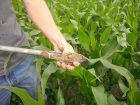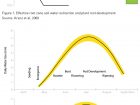
Features
Agronomy
Irrigation
How to find the best irrigation strategy
The goal of irrigation scheduling is to ensure the crop is never under water-induced stress that would limit yield potential. It involves determining the correct amount of irrigation water to apply to a crop at the right times to achieve optimum yield.
March 28, 2018 By Ross H. McKenzie PhD P. Ag.
 A close up of a 1” Dutch auger checking moisture in an irrigated corn field. The goal of irrigation scheduling is to ensure the crop is never under water-induced stress
A close up of a 1” Dutch auger checking moisture in an irrigated corn field. The goal of irrigation scheduling is to ensure the crop is never under water-induced stressSome of the important things you need to know include:
- The soil texture of fields to estimate the water holding capacity and amount of plant available water of each soil type in each field
- The allowable depletion of soil moisture that can be removed from each soil type before irrigation is required. Allowable depletion will vary with each crop
- Check soil moisture content of each field frequently throughout the season
- Know the daily water use of each crop at each growth stage
- Know the effective rooting depth of each crop
- Know the irrigation system gross and net water output to apply specific amounts of irrigation water (see “Making the most of your pivot irrigation”).
To make irrigation management decisions, an irrigator must be able to measure soil moisture levels in each field, know the daily water use of each crop, and know the net water application of each irrigation system. With this knowledge, an irrigator can develop a practical scheduling plan for each field based on sound management information.
At the start of the growing season, an irrigation manager must ensure adequate water is available for seed germination for excellent emergence and early crop growth, by application of light, frequent water application.
This is possible with pivot irrigation systems, which apply rates as low as seven millimetres (mm) with a quarter section pivot in a 24-hour period. The advantage of pivot irrigation is the flexibility of applying irrigation water in varying amounts depending on water requirements. Water can be applied during early crop stages to promote vigorous growth and at the same time, apply additional water to increase available soil water reserves in the entire plant root zone to provide a reserve of water during peak crop water use later in the growing season.
The amount of water available to a crop depends on the water-holding capacity of a soil and the effective root zone depth for each crop. Allowable depletion (AD) is the amount of plant available water (PAW) that can be depleted or removed by a crop without experiencing water stress.
For most crops, allowable depletion is about 40 per cent of the available water. The AD will vary with soil type, crop type, stage of crop growth and effective rooting depth of the crop. Determining AD for the crop in each field is essential for effective on-farm irrigation scheduling program to meet crop water requirements.
Understanding effective crop rooting depths
The effective rooting depth of a crop is where most of plant roots are concentrated and extract water for plant uptake. For annual crops, rooting depth gradually increases during vegetative growth, and as plants shift from vegetative to reproductive growth, downward rooting ceases for most annual crops.
Figure 1 shows a generalized example for annual crop root development and depth of growth over a growing season. The effective rooting zone (ERZ) is the soil depth where plant roots take up their water.
Typically, roots are more concentrated in the upper half of the root zone. As a result, plants usually extract the majority of their water requirements from the upper half of the effective root zone, where there is a greater abundance of roots and water is easily accessed. Also, in the upper half of the root zone, soil temperature is warmer, soil organic matter levels are higher, soil biological activity is greater, plant available nutrient levels are higher and soil aeration is more favorable, all of which provide desirable conditions for more abundant plant root development.
Figure 1 also shows that about 40 per cent of crop water is taken up from the upper 25 per cent of the root zone and about 30 per cent of water comes from the second quarter of the root zone for a total of 70 per cent of a plant’s water requirements. In the third and fourth quarters of the root zone, only 20 and 10 per cent of water is taken up, respectively, for a total of 30 per cent of plant water requirements.
For most annual crops growing in soil with good moisture, about 70 per cent of crop water requirement is taken up from the upper half of the ERZ. For irrigation farmers, a very good irrigation management practice is to ensure good soil water is maintained in the upper half to the ERZ throughout the growing season to prevent crop water stress.
For cereal and oilseed crops, the effective rooting depth is typically about 100 centimetres (cm) under favourable soil and environmental conditions, but take up about 70 per cent of their water requirements in the top 50 cm of the root zone. For irrigation farmers, an effective irrigation management strategy is to build up soil moisture to near field capacity in the full 100 cm root zone in the spring and early summer, and maintain soil moisture in the top 50 cm between field capacity and 60 per cent of field capacity throughout the growing season.
Crop water use and evapotranspiration
Crop water use is referred to as “evapotranspiration” (ET). ET is the combination of water evaporation from soil, and water used by plants for growth and transpiration. Transpiration refers to the water lost to the atmosphere through the stomata, which are small pores mostly on the underside of plant leaves, as the plants release water vapour to avoid heat stress.
The average amounts of water use are provided in Figure 2 for wheat and canola (developed from research in southern Alberta). Crop water use will vary slightly in different regions due to varying crop, soil and climatic condition differences. Water use can be quite variable depending on conditions such as temperature, humidity, solar radiation, day length, soil moisture level and wind. Daily water use can be over 10 mm per day for a number of crops when weather is very hot and windy.
Irrigation farmers in southern Alberta can access the Alberta Agriculture site: agriculture.alberta.ca/acis/imcin/irricast.jsp and select the weather station nearest their farm to enter their crop information to find out the actual daily water use for each of their crops.
Pivot irrigation operation and management
Pivot systems are designed to apply light, frequent amounts of irrigation water. Pivots are not designed to apply a large amount of water at one time. An important point for pivot irrigation farm managers is to know the gross and net water output of each pivot irrigation system on their farm. If net water application is over or under estimated, the results could return in over or under application of irrigation water which could lead to reduced crop growth and yield.
For pivot irrigation, scheduling decisions should be based on crop water use on a daily basis and keeping soil moisture between field capacity and safe depletion point. Water management of pivot irrigation is typically for the upper half of the root zone. This means application of light and frequent water application is required to match the water use of a crop.
Measuring soil moisture
The ability to rapidly and accurately measure soil moisture is critical for irrigation and dryland farmers. Knowing soil moisture level relative to field capacity and wilting point is necessary to determine the amount of water in soil. There are a number of different tools that can be used to measure soil moisture.
For most farmers, the simplest and easiest way is using the hand-feel method. This procedure uses a Dutch soil auger or soil probe to take soil samples from specific depths in the plant root zone and feel the soil to estimate the soil water content. Different soil textures have a unique feel with specific characteristics relative to the soil water content. With experience, a farmer can reasonably estimate a soil’s moisture content.

